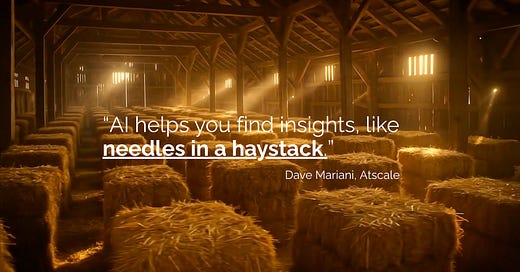AI is a Needle-Finder, Not an Answer-Giver
Semantic layers and their role in extending our minds
At last week’s Semantic Layer Summit, Dave Mariani of AtScale suggested that the true power of AI isn't giving us faster answers; it’s about finding insights, like needles in a haystack. Philosophers Andy Clark and David Chalmers argue that tools like a semantic layer extend our cognitive apparatus for navigating information haystacks.
AI, when used with a semantic layer that encodes corporate knowledge, can evolve the craft of analysis from query-answering to insight discovery, fundamentally changing the user's interaction with data.
Analysts Are Evolving
Analysts are evolving from query facilitators to insight discoverers.
For example, instead of a marketing manager using a business intelligence tool to ask questions about campaign performance, they might first use AI with a semantic layer to unearth connections that had previously gone unseen, like "Campaign X seems to be underperforming in the Midwest region due to ad creative misalignment with local preferences, as suggested by weak campaign KPI performance and higher than average negative sentiment from agent conversations."
The semantic layer, according to Mariani, provides the structured context (campaign definitions, demographics, metrics) that AI can use to connect dots and spot anomalies. Without semantic context, AI may surface interesting but business-irrelevant findings.
The Extended Search Party
As Andy Clark and David Chalmers suggest in their essay, The Extended Mind, "Your mind includes your tools." AI is a tool that extends our mind beyond individual cognition. When designed well, semantic layers and AI systems can be part of our extended cognitive apparatus for navigating information haystacks.
Semantic layers help AI guide us toward insights buried deep in haystacks of research, data, and language. Deciding which insights matter is up to you.
This post is a part of a multi-part series about ideas shared in the 2025 Semantic Data Layer Summit. It explores topics like: Is data visualization dying, or is it just getting started? How can AI best leverage data to ensure its insights are accurate? What role do semantic layers play in the agentic applications of today and tomorrow?





We're trying to apply that semantic layer at the company I'm at now. The hard part is having the analysists step back to ask the right question because it goes from a data question to, as you said, an insight question. It's a completely different approach to the same data.
Here's the link to this post on LinkedIn, and follow up discussion: https://www.linkedin.com/posts/markwpalmer_according-to-david-p-mariani-of-atscale-activity-7340365287801692163-4Td5?utm_source=share&utm_medium=member_desktop&rcm=ACoAAAACkNMB_k9WyOC8JUkEVVeLoX40sXdUA-4